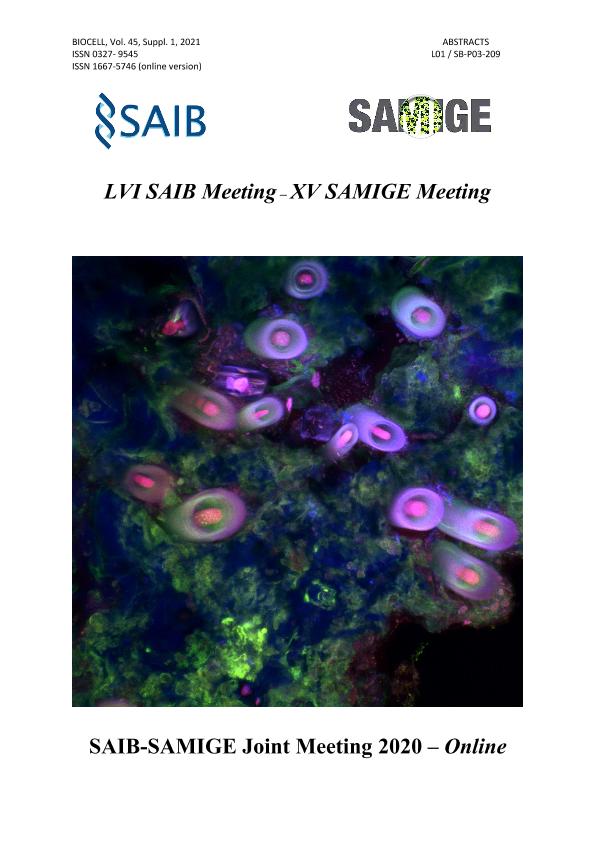Evento
Cis-elements enrichment analysis on Prunus persica co-regulated genes during infection with Taphrina deformans
Novello, María Angelina ; Gismodi, Mauro; Valentini, Gabriel Hugo; Drincovich, Maria Fabiana
; Gismodi, Mauro; Valentini, Gabriel Hugo; Drincovich, Maria Fabiana ; Lara, Maria Valeria
; Lara, Maria Valeria
 ; Gismodi, Mauro; Valentini, Gabriel Hugo; Drincovich, Maria Fabiana
; Gismodi, Mauro; Valentini, Gabriel Hugo; Drincovich, Maria Fabiana ; Lara, Maria Valeria
; Lara, Maria Valeria
Tipo del evento:
Reunión
Nombre del evento:
LVI Annual Meeting Argentine Society for Biochemistry and Molecular Biology; XV Annual Meeting Argentinean Society for General Microbiology
Fecha del evento:
02/11/2020
Institución Organizadora:
Sociedad Argentina de Investigación en Bioquímica y Biología Molecular;
Sociedad Argentina de Microbiología General;
Título de la revista:
Biocell
Editorial:
Tech Science Press
ISSN:
0327-9545
e-ISSN:
1667-5746
Idioma:
Inglés
Clasificación temática:
Resumen
Peach Leaf Curl is a widely worldwide distributed disease that affects peach trees and generates millions of dollars losses each year. The causal agent is the dimorphic fungus Taphrina deformans. The disease is currently controlled by fungicides. Nevertheless, to reduce risks to health and the environment, the use of strategies based on genetically resistant materials is required. Here, to get insight into host responses against the pathogen, leaves of susceptible and resistant P. persica genotypes, DOFI-71.043.018 (DS) and DOFI-84.364.060 (DR), respectively, were inoculated with T. deformans. Samples were collected at 0, 12 and 96 hours post inoculation (hpi). RNAseq analysis was used to elucidate transcriptomic peach early responses to the infection with the pathogen. Comparisons between 0 and 12 hpi, and 0 and 96 hpi (DS12-DS0, DR12-DR0, DS96-DS0, DR96-DR0) were made in both genotypes and presented previously. Here, to identify transcription factors responsible for the expression behavior of responsive genes, as a first step, an analysis of their proximal regulatory regions was conducted. For this purpose, several clusters of co-regulated genes were generated. A 1500 bp of upstream sequence from the translational start site of each gene was downloaded from Phytozome database. A transcription factor binding sites enrichment analysis on the promoter regions of the different clusters was performed with cisAnalyzer. The statistical analysis was carried out both against a random control group and against the whole genome with the aid of Rstudio. By this approach, we selected 10 clusters that arranged 720 responsive genes. In each cluster, between 153 and 201 unique motifs related to abiotic and biotic stress, phyohormones, signaling, light and sugar response were identified. On one hand, 82% of the genes induced in all conditions presented JAI1/JIN1BS motif and a 70 % presented JARE motif in their promoters indicating that they may be regulated by jasmonic acid. On the other hand, only one motif, ABRE-RELATED was significantly enriched in the cluster of repressed genes in both genotypes and times. This cis element is known to respond to cold and dehydration stimuli. Moreover, 85% and 95% of up-regulated genes in DS presented motifs associated with auxins and cytokinins responses, respectively. In contrast, the majority of repressed genes showed in their sequence a PR-10ASEBFBS motif, related to biotic stress. In down-regulated DR genes, MYBC1BS (cold-stimulus related) and SRE (sugar-response element) were significantly enriched. In contrast, exclusively up-regulated genes in DR only displayed under-enriched cis-elements. Together, in both genotypes a general down regulation of abiotic stress responses and an induction of jasmonic responsive genes is observed when facing the pathogen. It is interesting the presence of auxin-responsive motifs in DS up-regulated genes since disease symptoms in infected leaves could be related to this hormone.
Palabras clave:
PRUNUS PERSICA
,
PROMOTER
,
RNA SEQ
,
TAPHRINA DEFORMANS
Archivos asociados
Licencia
Identificadores
Colecciones
Eventos(CEFOBI)
Eventos de CENTRO DE EST.FOTOSINTETICOS Y BIOQUIMICOS (I)
Eventos de CENTRO DE EST.FOTOSINTETICOS Y BIOQUIMICOS (I)
Citación
Cis-elements enrichment analysis on Prunus persica co-regulated genes during infection with Taphrina deformans; LVI Annual Meeting Argentine Society for Biochemistry and Molecular Biology; XV Annual Meeting Argentinean Society for General Microbiology; Ciudad Autónoma de Buenos Aires; Argentina; 2020; 127-127
Compartir



